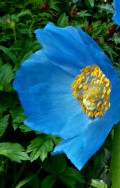 This herbaceous perennial is a member of the poppy family (Papaveraceae) and produced by a cross made in 1934 between M. grandis and M. betonicifolis. The mid green leaves are hairy, toothed, and lance-shaped. In late spring to early summer, rosettes of leaves produce tall leafy stems bearing single drooping buds that slowly open to cup-shaped vivid blue flower three to four inches across with four long pointed petals and dark yellow stamens. The flowers appear over a six week period giving eye catching color to the garden. Blue poppies tend to die after flowering so to avoid this grow in cool moist soil and prevent the plants from flowering for two years. This is a striking plant but difficult to grow unless you have the right growing conditions for it: cool temperatures, moist soil, and partial shade.
This herbaceous perennial is a member of the poppy family (Papaveraceae) and produced by a cross made in 1934 between M. grandis and M. betonicifolis. The mid green leaves are hairy, toothed, and lance-shaped. In late spring to early summer, rosettes of leaves produce tall leafy stems bearing single drooping buds that slowly open to cup-shaped vivid blue flower three to four inches across with four long pointed petals and dark yellow stamens. The flowers appear over a six week period giving eye catching color to the garden. Blue poppies tend to die after flowering so to avoid this grow in cool moist soil and prevent the plants from flowering for two years. This is a striking plant but difficult to grow unless you have the right growing conditions for it: cool temperatures, moist soil, and partial shade.
Type: Herbaceous perennial
Bloom: Vivid blue nodding cup-shaped flowers three to four inches across with dark yellow stamens in late spring to early summer
Size: 2-3’ H x 1’ W
Light: Partial to full shade
Soil: Fertile, moist, well-drained, acid, cool
Hardiness: Zones 7-8
Care: Do not allow blooming for two years; divide every three to four years.
Pests and Diseases: Slugs, snails
Propagation: Division in spring or fall; fresh seed for fertile cultivars
Companion Plants: Hosta, ferm, astilbe